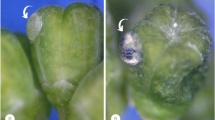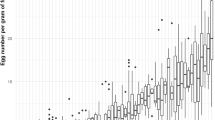Abstract
The European vine moth Lobesia botrana Denis & Schiff. (Lepidoptera: Tortricidae) is a key pest in the vineyards of Israel and Europe. Traps baited with the female sex pheromone are commonly used to monitor the pest population. However, the role of the vine cultivars on monitoring the moth population using pheromone-baited traps was not yet studied. The present study aimed to identify the effect of grape cultivars on L. botrana adult distribution patterns in the field, in order to achieve a better understanding of the monitored data in respect to male and female’s host preference. The 3-year study in commercial vineyards used four cultivars: Carignan, Emerald Riesling, French Colombard, and Cabernet Sauvignon. The moth population of each generation was estimated from male counts in pheromone traps; three generations were observed in all experimental orchards, each year. Female host choice was studied by monitoring freshly deposited eggs and newly hatched larvae on vines. The study showed a significant effect of cultivar on numbers of trapped males in most years, and a cultivar effect on female host choice. For both males and females and for all phenological stages of the grapes, Carignan and French Colombard attracted the most and Cabernet Sauvignon the fewest specimens. The results show that cultivar blend within the vineyard can affect the distribution pattern of the pest. Knowledge of the expected choice of the female moth, and of the timing of its decision could lead to an improved monitoring system, with the preferred cultivar as an indicator.



Similar content being viewed by others
References
Anshelevich L, Kehat M, Dunklblum E, Greenberg S (1994) Sex pheromone traps for monitoring the European vine moth, Lobesia botrana: effect of dispenser type, pheromone dose, field aging of dispenser, and type of trap on male captures. Phytoparasitica 22:281–290. doi:10.1007/BF02980529
Arn H, Louis F (1997) Mating disruption in European vineyards. In: Carde RT, Minks AK (eds) Insect pheromone research. Chapman and Hall, New York, pp 377–382
Barclay HJ, Judd GJR (1995) Models for mating disruption by means of pheromone for insect pest control. Res Popul Ecol 37:239–247. doi:10.1007/BF02515826
Cardé RT, Minks AK (1995) Control of moth pests by mating disruption: successes and constraints. Annu Rev Entomol 40:559–585. doi:10.1146/annurev.en.40.010195.003015
Coracini M, Bengtsson M, Liblikas I, Witzgall P (2004) Attraction of codling moth males to apple volatiles. Entomol Exp Appl 110:1–10. doi:10.1111/j.0013-8703.2004.00124.x
Eichhorn KW, Lorenz DH (1977) Phanologische Entwicklungsstadien. der rebe nachrichtenbl Dtsch Planzenschtzdienstes (Braunschweig) 29:119–120
Fermaud M (1998) Cultivar susceptibility of grape berry clusters to larvae of Lobesia botrana (Lepidoptera:Tortricidae). J Econ Entomol 91:974–980
Gabel B, Roehrich RR (1995) Sensitivity of grapevine phenological stages to larvae of European grapevine moth, Lobesia botrana Den. et Schiff. (Lep., Tortricidae). J Appl Entomol 119:127–130
Gabel B, Thiery D, Suchy V, Marion-Poll F, Hradsky P, Farkas P (1992) Floral volatiles of Tanacetum vulgare L. attractive to Lobesia botrana Den. et Schiff. females. J Chem Ecol 18:693–701. doi:10.1007/BF00994607
Gordon D, Zahavi T, Anshelevich L, Harel M, Ovadia S, Dunkelblum E, Harari AR (2005) Mating disruption of Lobesia botrana Den. & Schiff. Lepidoptera: Tortricidae): the effects of pheromone formulations and concentrations. J Econ Entomol 98:135–142
Harari AR, Zahavi T, Gordon D, Anshelevich L, Harel M, Ovadia S, Dunkelblum E (2007) Pest management programmes in vineyards using male mating disruption. Pest Manag Sci 63(8):769–775. doi:10.1002/ps.1365
Kast WK (2001) Twelve years of practical experience using mating disruption against Eupoecilia ambiguella and Lobesia botrana in vineyards of the Wuerttemberg region, Germany. IOBC WPRS Bull 24:71–74
Knight AL, Light DM (2001) Attractants from Bartlett pear for codling moth, Cydia pomonella (L.), larvae. Naturwissenschaften 88:339–342. doi:10.1007/s001140100244
Light DM, Knight AL, Henrick CA, Rajapaska D, Lingren B, Dickens JC, Reynolds KM, Buttery RG, Merrill G, Roitman J, Campbell BC (2001) A pear-derived kairomone with pheromonal potency that attracts male and female codling moth, Cydia pomonella (L.). Naturwissenschaften 88:333–338. doi:10.1007/s001140100243
Louis F, Schirra KJ (2001) Mating disruption of Lobesia botrana (Lepidoptera: Tortricidae) in vineyards with very high population densities. IOBC WPRS Bull 24(2):75–79
Maher N, Thiery D, Städler E (2006) Oviposition by Lobesia botrana is stimulated by sugars detected by contact chemoreceptors. Physiol Entomol 31:14–22. doi:10.1111/j.1365-3032.2005.00476.x
Maher N, Toulouse ME, Jolivet J, Thiery D (2000) Oviposition preference of the European grapevine moth, Lobesia botrana (Lepidoptera: Tortricidae) for host and non-host plants present in Bordeaux area. Integrated Control in Viticulture IOBC/wprs Bull 23(4):131–134
Masante-Roca I, Gadenne C, Anton S (2002) Plant odour processing in the antennal lobe of male and female grapevine moths, Lobesia botrana (Lepidoptera: Tortricidae). J Insect Physiol 48:1111–1121. doi:10.1016/S0022-1910(02)00204-4
Menendez R, Thomas CD (2000) Metapopulation structure depends on spatial scale in the host-specific moth Wheeleria spilodactylus (Lepidoptera: Pterophoridae). J Anim Ecol 69:935–951. doi:10.1046/j.1365-2656.2000.00449.x
Moreau J, Benrey B, Thiéry D (2006a) Grape variety affects larval performance and also female reproductive performance of the European grapevine moth Lobesia botrana (Lepidoptera: Tortricidae). Bull Entomol Res 96:205–212. doi:10.1079/BER2005417
Moreau J, Arruego X, Benrey B, Thiery D (2006b) Differences in nutritional quality of parts of Vitis vinifera berries affect fitness of the European grapevine. Entomol Exp Appl 119:93–99. doi:10.1111/j.1570-7458.2006.00390.x
Savopoulou-Soultani M, Stavridis DG, Tzanakakis ME (1990) Development and reproduction of Lobesia botrana on vine and olive inflorescences. Entomol Hell 8:29–35
Savopoulou-Soultani M, Nikolaou N, Milonas PG (1999) Influence of maturity stage of grape berries on the development of Lobesia botrana (Lepidoptera: Tortricidae) larvae. J Econ Entomol 92:551–556
Stavridis DG, Savapoulou-Soultani M (1998) Larval performance and oviposition preference for known and potential hosts by Lobesia botrana (Lepidoptera: Tortricidae). Eur J Entomol 95:55–63
Tasin M, Bäckman AC, Bengtsson M, Ioriatti C, Witzgall P (2006) Essential host plant cues in the grapevine moth. Naturwissenschaften 93:141–144. doi:10.1007/s00114-005-0077-7
Tasin M, Bäckman AC, Coracini M, Casado D, Ioriatti C, Witzgall P (2007) Synergism and redundancy in a plant volatile blend attracting grapevine moth females. Phytochemistry 68:203–209. doi:10.1016/j.phytochem.2006.10.015
Thiéry D, Gabel B (2000) Oviposition behaviour of the European grapevine moth in response to extracts of Muller thurgau flowering stages. Integrated control in viticulture. IOBC WPRS Bull 24:135–138
Thiéry D, Moreau J (2005) Relative performance of European grapevine moth (Lobesia botrana) on grapes and other hosts. Oecologia 143:548–557. doi:10.1007/s00442-005-0022-7
Thiéry D, Rétaud P, Dumas-Lattaque L, Féru R, Xuéreb A, Bourriau F (2006) Trapping Lobesia botrana females with apple juice: a valuable tool to predict oviposition? IOBC WPRS Bull 29:235–240
Torres-Vila LM, Rodriguez-Molina MC (2002) Egg size variation and its relationship with larval performances in the Lepidoptera: the case of the European grapevine moth Lobesia botrana. Oikos 99:272–283. doi:10.1034/j.1600-0706.2002.990207.x
Torres-Vila LM, Rodriguez-Molina MC, Roehrich R, Stockel J (1999) Vine phenological stage during larval feeding affects male and female reproductive output of Lobesia botrana (Lepidoptera: Tortricidae). Bull Entomol Res 89:549–556. doi:10.1017/S000748539900070X
Varandas S, Teixeira MJ, Marques JC, Aguiar A, Alves A, Bastos MMSM (2004) Glucose and fructose levels on grape skin: interference in Lobesia botrana behaviour. Anal Chim Acta 513:351–355. doi:10.1016/j.aca.2003.11.086
Yamamura K (2002) Biodiversity and stability of herbivore populations: influence of the spatial sparseness of food plants. Popul Ecol 44:33–40. doi:10.1007/s101440200004
Yan F, Bengtsson M, Witzgall P (1999) Behavioral response of female codling moths, Cydia pomonella, to apple volatiles. J Chem Ecol 25:1343–1351. doi:10.1023/A:1020978826346
Zhang A, Linn JC, Wright S, Prokopy R, Reissig W, Roelofs W (1999) Identification of a new blend of apple volatiles attractive to the apple maggot, Rhagoletis pomonella. J Chem Ecol 25:1221–1232. doi:10.1023/A:1020910305873
Acknowledgments
This research was supported by the Israeli Ministry of Science, Chief Scientist’s Foundation, Grant No 339. We thank the vine growers in the research area for collaboration.
Author information
Authors and Affiliations
Corresponding author
Additional information
Communicated by M. Toth.
Rights and permissions
About this article
Cite this article
Sharon, R., Zahavi, T., Soroker, V. et al. The effect of grape vine cultivars on Lobesia botrana (Lepidoptera: Tortricidae) population levels. J Pest Sci 82, 187–193 (2009). https://doi.org/10.1007/s10340-008-0238-5
Received:
Revised:
Accepted:
Published:
Issue Date:
DOI: https://doi.org/10.1007/s10340-008-0238-5




